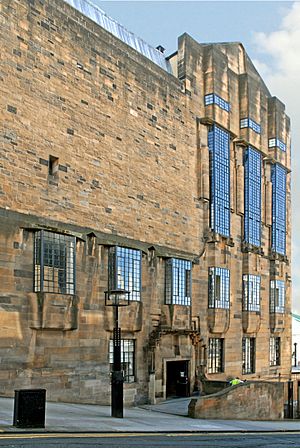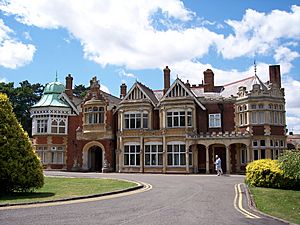Margot Sandeman facts for kids
Quick facts for kids
Margot Sandeman
|
|
|---|---|
| Born |
Margot Sandeman
27 May 1922 Glasgow, Scotland
|
| Died | 17 January 2009 (aged 86) |
| Education | Glasgow School of Art |
| Known for | Painting |
|
Notable work
|
Sheep Resting on the Shore |
| Spouse(s) | James Robson |
| Awards | Guthrie Award, 1958 |
Margot Sandeman (born May 27, 1922 – died January 17, 2009) was a talented Scottish painter. She was a very close friend of artist Joan Eardley. Margot also worked with the poet Ian Hamilton Finlay for a long time. She became well-known for her beautiful paintings of Scotland's West Coast. She also painted country scenes, indoor spaces, and still life pictures.
Contents
Margot's Early Life
Margot Sandeman was born in Glasgow, Scotland. She came from a family of artists. Her father, Archibald Sandeman, was a painter who taught himself. Her mother, Muriel Boyd, was a famous embroiderer.
Margot grew up in Bearsden in a very creative home. Her family was inspired by William Morris and the Arts and Crafts movement. Her mother even decorated their home with inspiring phrases. One said, "Bread feeds the body but flowers the soul."
Her Art School Days
Margot studied art at the Glasgow School of Art. Other famous artists, like Joan Eardley, and the poet Ian Hamilton Finlay, were there at the same time. Margot was already a skilled painter when she started art school.
She was one of a few students chosen for special training. This training was led by Hugh Adam Crawford, who was in charge of drawing and painting. Both Margot and Joan Eardley did very well under his teaching. Crawford once said that Margot's paintings had a "hidden structure" that you couldn't just see with your eyes.
Friendship with Joan Eardley
Margot Sandeman and Joan Eardley first met at the Glasgow School of Art. They quickly became very good friends.
They were both a bit shy at first. Margot remembered, "We were very shy of each other for about a year." But their mothers helped them break the ice. They encouraged them to take a Red Cross course together. Margot said, "We started having to bandage each other, that broke the ice! After that we became tremendously great friends."
Both artists lived in Bearsden. Even though their painting styles were different, they supported each other. They often drew and painted together. They also went on camping trips and family holidays. In 1941, while still students, they bought a horse and caravan. They traveled, sketched, and painted around Loch Lomond. For many years, they often visited High Corrie on the Isle of Arran. They rented a small building called "The Tabarnacle" to use as their art studio.
An art critic from The Scotsman newspaper wrote about their work in the 1940s. They said that Margot and Joan "more than maintain the exciting promise of their first appearances." The critic also noted that "Both are quite fearless and convinced exponents of highly individual outlooks."
Margot's Art and Career
Margot finished art school during World War II. In 1942, she went to Bletchley Park. This was a secret place where people worked to break enemy codes. Margot worked there for six months.
After leaving Bletchley Park, Margot took care of her mother. She then got an art studio in Glasgow. Her first works there were bright still life paintings. To earn money, she also painted old-looking designs on lampshades.
In 1946, Margot married James Robson, who was a teacher and a ceramic artist. They had two sons together.
Margot was a very active artist. She painted outdoors, in her studio, and from her memory. She created unique paintings of Scottish landscapes, country scenes, interiors, and still life. She also worked often with the poet Ian Hamilton Finlay.
As she got older, Margot continued to create more and more art. She made a special series of paintings to celebrate Robert McLellan. He was a Scottish writer and poet who lived near her in High Corrie.
Exhibitions and Awards
Margot Sandeman showed her art in many places. She exhibited at The Royal Scottish Academy from 1946 to 1972. Her art was also shown at galleries like Cyril Gerber Fine Art, Compass Gallery, and the Hughson Gallery in Glasgow. She also had shows at the Talbot Rice Gallery in Edinburgh and the Lillie Art Gallery in Glasgow.
Her main solo shows were at the Richard Demarco Gallery in Edinburgh, starting in 1974.
Margot won several awards for her art. In 1964, she received the Guthrie Award from the Royal Scottish Academy. In 1970, she won the Redpath Award from the Society of Scottish Artists. She also received an award from the Scottish Arts Council in 1970. In 1989, she was the Scottish winner in the Laing Competition.
Where to See Her Art
Margot Sandeman's artwork is part of the permanent collections in many important places. You can see her paintings at the National Galleries of Scotland, the University of Stirling, and the Glasgow Life Museums. Her work is also in The Fleming Collection, among others.
See also
- Art in modern Scotland
- Landscape painting in Scotland



